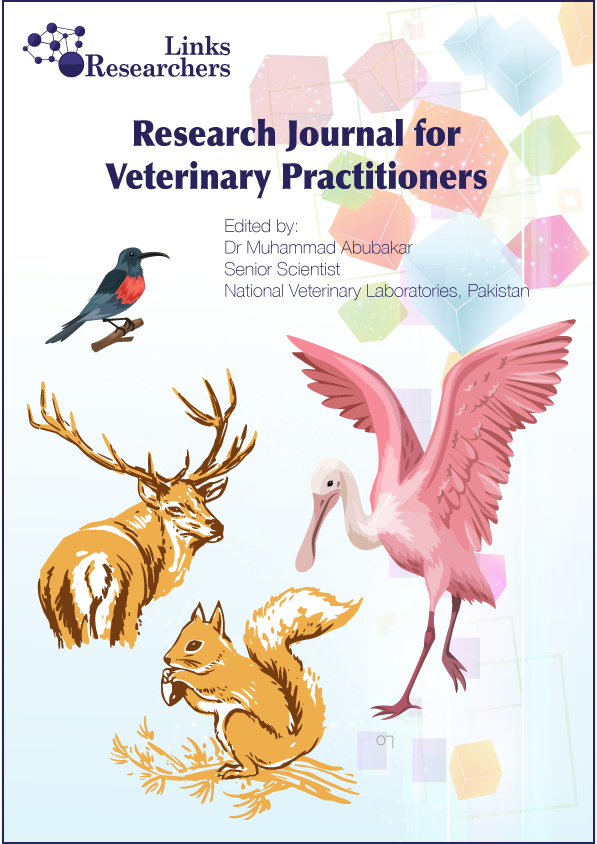Muhammad Mudassar Shahzad1*, Syed Makhdoom Hussain1, Farhat Jabeen1, Abdullah Ijaz Hussain 2,Sajjad Ahmad3, Abida Ashraf4,Muhammad Zubair-ul-Hassan Arsalan1
Honghai Zhang1,*, Yao Chen1, Xiaoyang Wu1, Shuai Shang2, Jun Chen2, Jiakuo Yan1, Qinguo Wei1, Xibao Wang1, Yongqiang Lu3 and Huanxin Zhang2
Md. Aminul Islam1*, A.N.M. Aminoor Rahman2, Mohammad Shah Alam3 and Md. Taimur Islam4
Fahima Khatun1, Abdullah-Al-Maruf2, Md. Mizanur Rahman2, Afroja Yasmin1, Mohammad Ali Zinnah3, Md. Aminul Islam4 and Mohammad Shah Alam5*
Ijaz Rasool Noorka1,2*, Bilal Ahmad Khan3*, Kafeel Ahmad4, Zafar Iqbal Khan4, Muhammad Ather Nadeem3, Amer Nawaz2, Tasneem Ahmad5 and Humayun Bashir4
Neven Waheeb1*, Sherif Marouf2, Essam Nasr3, Shaymaa Abdelmalek2
Wafaa M.A. Ghoneem, Reham R. El-Tanany and Adel E.M. Mahmoud*
Nkiru E. Ekechukwu, Felicia N. Ekeh, Chinenye M. Ohanu, Hope C. Ezinwa and Ifeanyi Oscar N. Aguzie*
Shahan Azeem1*, Muhammad Akram Muneer2, Liaquat Ahmad3, Sameera Akhtar1 and Talat Naseer Pasha4,5
Indyah Aryani 1,3*, Suyadi Suyadi2, Hartutik Hartutik2, Kuswati Kuswati2
Syeda Batool Zehra1, Abdullah G. Arijo2, Aly Khan3, Nasira Khatoon1* and Samina Waheed1
Kamilla Gadzhimuradovna Alieva1, Patimat Mitkhatovna Daniyalova1, Svetlana Aleksandrovna Shemyakova2*, Kerim Khasanovich Bolatchiev2, Ismail Anatolyevich Bittirov3
Khasan Khamidovich Shakhbiev1*, Saidkhamzat Saidmagomedovich Abumuslimov1, Larisa. Vakhaevna Taramova1, Islam Khasanovich Shakhbiev1, Svetlana Aleksandrovna Shemyakova2
Trisiwi Wahyu Widayati1*, Aris Triyono Syahputra2, Andoyo Supriyantono1, Onesimus Yoku1, Deny Anjelus Iyai1, Priyo Sambodo1, Iriani Sumpe1
Songruo Tao1, Cuiyi Liao1, Jinju Peng1, Yuexia Ding1,* and Yi Ma1,2,*
Khitam J. Yahya*, Mohammed T. S. Al-Zubaidi
Muhammad Saad Waqas, Li Xia, Tian-Ci Yi*, Liang-Yu Sun, Rong Xiao and Dao-Chao Jin*
Kétomon Pierre Challaton1*, Coovi Guénolé Akouedegni1, Kadoéito Cyrille Boko2, Goué Géorcelin Alowanou1,3, Pascal Venant Houndonougbo4, Aboudou Habirou Kifouly1, Mawulé Sylvie Hounzangbé-Adoté1
Vijay Kumar1, Asghar Ali Kamboh1*, Nazar Ali Korejo1, Ambreen Leghari2, Faiz Muhammad Khand2, Riaz Ahmed Leghari1, Khaliq-ur-Rehman Bhutto3
Umar Salisu Ahmad1, Adamu Abdul Abubakar1,2*, Hassan Abubakar Bodinga1, Nura Abubakar1, Ekaete Ime Oviawe1, Zaid Shehu3, Abubakar Musa Mayaki3
Sara H. Zughayyar*, Amer H. Gyad
Luthfiralda Sjahfirdi1*, Lisa Nurfalah1, Deanvi Fahira Wisnuputri1, Entang Iskandar2
Diky Ramdani1*, Dwi Cipto Budinuryanto1,2, Siti Darodjah Rasad1, Novi Mayasari3, Krisna Rizki Rismawan1, Muhammad Fajryanto Solihin1, Ririn Siti Rahmatillah1
Muhammad Shuaib1*, Abdul Hafeez1, Woo Kyun Kim2, Aamir Khan3 and Abubakar Sufyan4
Jinzhao Li1, Yawen Zhang2, Binghan Jia1, Yuqiong Zhao1, Huijuan Luo1, Xiaojie Ren1, Yuan Li3, Xiaoyan Bai1, Jing Ye3 and Junping Li1*
Claude Mona Airin1*, Miyayu Soneta Sofyan2, Galy Hardyta3, Khrisdiana Putri4, Pudji Astuti1
Muhammad Shuaib1*, Abdul Hafeez1, Sarzamin khan1, Muhammad Shahkar Uzair1, Abubakar Sufyan2 and Muhammad Ayaz3
Wei Li1, Xvming Qi2, Xueli Lu3, Li Yuan4 and Huaiqing Deng1*
Zhenyu Chang1,3, Qingqing Xiao1,2, Yourong Ye1,2, Mujahid Iqbal4, Mengqi Duan1,2, Yangzom Chamba1,2* and Peng Shang1,2*
Camilo Romero Núñez1, Laura Miranda Contreras1, Rafael Heredia Cárdenas1, Ariadna Flores Ortega2*, Linda Guiliana Bautista Gómez3
Azhar Ali1, Faheem Ahmed Khan2, Wu Di3, Huang Chunjie3, Muhammad Rizwan Yousaf1, Bilal Ahmed1, Farwa Shakeel1, Nuruliarizki Shinta Pandupuspitasari1, Windu Negara2, Bambang Waluyo Hadi Eko Prasetiyono1*
Maysoon S. Abbas, Shaimaa N. Yassein
Muhammad Ardas Daruslam1, Muhammad Irfan Said2*, Nancy Lahay3
Catur Suci Purwati1, Chusnul Hanim2*, Lies Mira Yusiati2, Budi Prasetyo Widyobroto3
Hussein Jabar Jasim*, Naer Abdulbari Madlool Alkaabawi, Ali Naser Kathem
Nguyen Khanh Thuan1*, Bui Thi Le Minh1, Ngo Van Thong1,2, Nguyen Ho Thanh Tuyen1, Nguyen Lam Truong1, Pham Minh Thien1
Mahmoud Ezzat1, Fatma Youssef2, Ahmed Eid1, Marwa E. Abo Hashem1*
Abdullah Khazal Mohsen1, Sura Emad Jassim2, Tania T. Alaridhi3, Amran M. Al-Erjan4, Qais R. Lahhob5*, Mustafa Mudhafar6,7
Suhad I.J. Al-Asady1*, Mohammad H. Al-Hasnawy2
Featuring
-
Indole-3-Carbinol of Broccoli Powder Can Decrease Estrogen Production in Male Rats
Reski Amalia, Claude Mona Airin, Pudji Astuti, Agung Budiyanto
J. Anim. Health Prod., Vol. 12, Iss. 4, pp. 647-653
-
Effect of Dietary Supplementation of Humic Acid on Blood Parameters, Antioxidant Activity, Serum and Bone Minerals in Laying Hens
Muhammad Mudasir Mushtaq, Safdar Hassan, Muhammad Sharif, Arfan Asghar, Fawwad Ahmad, Muhammad Khalid Bashir, Muhammad Ashraf, Mukarram Bashir, Tahreem Fatima, Muzammal Mushtaq
J. Anim. Health Prod., Vol. 12, Issue, 4, pp. 639-646
-
Conservation of Local Geese (Anser Anser) in Egypt: Characteristics of Production Systems and Breeders’ Perception
Amal S.Omar, Mahmoud A. Ahmed, Nada A.S. El-Shahawy, Wael A.H. Ali, Sabbah F. Youssef, Hoda M.A. Shabaan, El-Sayed M. Abdel-Kafy
J. Anim. Health Prod., Vol. 12, Iss. 4, pp. 630-638
-
Protective Response of Zinc Oxide Nanoparticle with Chitosan Oligosaccharide on Intestinal Integrity, Goblet Cell Count, and Meat Quality of Broiler Chicken under Heat Stress
Syed Abdul Hadi, Jameel Ahmed Gandahi, Muhammad Ghiasuddin Shah, Saima Masood, Noor Samad Gandahi
J. Anim. Health Prod., Vol. 12, Iss. 4, pp. 621-629
Subscribe Today
Receive free updates on new articles, opportunities and benefits

© 2025 ResearchersLinks. All rights Reserved. ResearchersLinks is a member of CrossRef, CrossMark, iThenticate.










